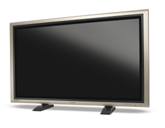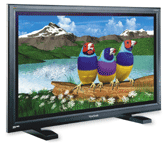Many workers prize small notebooks, personal digital assistants and cell phones, but the trend toward miniaturization stops at displays.Flat plasma displays now run between 32 and 63 inches and are priced anywhere from $2,500 to $25,000.A forecast by International Data Corp., a high-tech market research company in Framingham, Mass., predicts the plasma market, driven by consumer purchases, will average 74 percent annual growth through 2007, with about 3 million units to be sold that year. As for sizes, some forecasters are predicting that models up to 80 inches will be available in a year or two.Meanwhile, larger, faster and less expensive LCD screens are coming over the horizon. Thirty-inch models are plentiful, and 40-inch versions are starting to catch on. NEC-Mitsubishi recently released its 40-inch LCD4000, and Samsung USA released its 40-inch SyncMaster 403T earlier this year. And Sharp USA has a 37-inch model, the LC-3700.The market for large LCD displays might never be as robust as for plasma because of their higher production costs. The large, thin sheets of glass used in LCD displays are difficult to produce and manipulate; thus prices for a 40-inch LCD are typically at least a third higher than for a 42-inch plasma model.As for trade-offs between the two, plasma is a mature technology that is excellent for video. Screens will get even larger, and prices are coming down, particularly for 42-inch screens. Viewing angles of 160 degrees are the rule, and the brightness levels of plasma screens are generally higher than those of LCDs.On the downside, plasma screens are expensive and susceptible to burn-in from static images. They are heavier than LCDs and use more power.As for LCDs, the technology is still growing and is already popular with computer users'15-inch and 17-inch displays now outpace CRT monitors in sales. LCD screens are lighter and are better at displaying some types of graphics, such as Excel spreadsheets.But large LCDs are more expensive than comparable plasma models and not yet available in sizes exceeding 40 inches. While the video performance of LCD technology is improving, it doesn't yet keep pace with plasma. Finally, LCD technology doesn't provide the wide, 160-degree viewing angle of plasma, limiting the number of simultaneous viewers.For the time being, plasma displays hold a distinct edge over LCDs, both in terms of overall performance and price. So a plasma display would be my choice for a large monitor, and this is why I have listed only plasma displays in the chart accompanying this guide.If and when more large LCDs are released that are lighter and brighter and have higher resolutions than plasma displays'and if they reach a comparable price point'I might have to change my tune. But for now, I'll go with plasma.It's important to consider how a plasma display will be used before focusing on the features of a particular model. Aside from sports bars and home theaters, some government uses might include:Electronic signage. Plasma displays are found at airports, sports stadiums, trading floors and other environments requiring attractive and easily understood messaging in a large-enough format to be seen by hundreds of viewers simultaneously.Trade shows and meeting rooms. Plasma displays make meeting rooms attractive and allow impressive PC-based presentations and demos that can actually be seen by everybody in the room.Public information. Large plasma displays in public places such as lobbies and concourses enable rapid information dissemination from TV news broadcasts or PC-based information sources.Plasma screens are basically grids of tiny red, green and blue phosphors squeezed between two thin layers of glass. Charged electrons excite natural gases (argon, neon and xenon) within the glass. As the electrons excite the phosphors, oxygen atoms dissipate and create plasma, emitting ultraviolet light, which in turn reacts with the red, green and blue phosphors in each pixel to create visible light.[IMGCAP(2)] Unlike traditional displays where the images are scanned across the screen, the pixels in plasma displays are lit all at once, so the viewer never sees any flicker. And since plasma technology involves no electron beams, backlighting or light polarization, the resulting images are bright and clear, with rich colors and a wide viewing angle.Features and criteria to consider depend on how you use a plasma display.Price. Prices range from about $2,500, for Sony Electronics Inc.'s 42-inch PFM-42V1, to a deal price of $19,895 for a high-end behemoth like Fujitsu General America Inc.'s 63-inch P63XHA30WS.Screen size. Screen size is measured diagonally. Forty-two-inch displays, which have dropped rapidly in price over the last year, are the most popular with the general public for home use, but plasma envy demands that many users spend $5,000 or more for a larger screen. Fifty-inch screens are becoming popular in the business sector, where cost is less of a consideration than long-term performance.Resolution. A display's resolution is indicated by the number of pixels on the screen, horizontally and vertically. Native resolution describes the actual resolution of the plasma display and not the resolution of delivery (incoming) signals sent from a PC, notebook or DVD player.The closer the incoming signal is to the native pixel resolution of the screen, the better the picture will be. For example, a VGA computer signal of 853 by 480 will match up perfectly with a display with the same 853 by 480 resolution. Any disparity either way, and picture quality will suffer.The most advanced displays have an internal converter/scalar, which can make the necessary adjustments to arrive at a better resolution match between incoming signal and the display resolution.Contrast ratio. This is a measure of the difference between the brightest white and the darkest black the display can produce. The contrast ratio of plasma displays generally runs from 500:1 up. Listed contrast ratios above 600:1 aren't worth much to typical viewers, because they aren't visible to the human eye. Nevertheless, this is one important performance criterion to consider.Brightness. Brightness is measured by the amount of light that comes from an LCD screen displaying white, and is expressed as candelas per square meter (cd/m2). Most plasma displays emit at least 500 cd/m2, with some showing 1,000 cd/m2 and higher.Again, this is only one of many performance criteria; some leading vendors like Fujitsu General America Inc., JVC Company of America, NEC USA Inc. and Panasonic Consumer Electronics don't even bother listing brightness on their spec sheets.Color accuracy. High-end plasma screens can display up to 16.77 million colors for superb realism and subtle gradations between colors.Aspect ratio. Conventional NTSC TV (analog) signals are broadcast with a 4:3 aspect ratio, which leads to the somewhat square TV screens we have become accustomed to. A new industry standard calls for digital television, or DTV, for improving both picture and sound quality over conventional NTSC TV signaling.DTV programming can be delivered in two formats: standard analog definition (SDTV) or high definition (HDTV). HDTV is the highest form of digital television and represents the future for broadcast quality. All HDTV and some SDTV signals will be transmitted with an aspect ratio of 16:9, the same used for movies. Virtually all plasma displays employ the 16:9 widescreen format. Video format compatibility. The standard video formats are NTSC, PAL and SECAM. Ideally, the display you select will have all three.Video signal formats. Nearly all plasma TVs will accept composite and S-video transmission types that govern inputs from various types of devices. A new standard, component video, is being included on some DVD players, and offers superior video images. Check to see which displays can accept component video signals.Viewing angle. The 160-degree viewing angle of plasma displays lets many viewers see the screen perfectly from almost any angle, vertically or horizontally.Audio. Few plasma displays have built-in speakers like those of standard TV sets. Many manufacturers offer high-quality speakers as options.Dimensions and weight. Though many plasma displays are no more than three to five inches thick, don't think you can attach them to the wall with a lightweight picture hanger. They are quite heavy, with some of the largest weighing in at over 100 pounds. Often, your manufacturer will provide stands, wall units or even ceiling-mount devices. Given the cost of your display, this may be a job for a professional.
Gateway's 50-inch plamsa monitor/TV has 1,366- by 786-pixel resolution and a 600:1 contrast ratio. It's priced at $5,200.
The 50-inch VPW505 from ViewSonic priced at $5,359, has 1,366-by-786 resolution and a 1,000:1 contrast ratio.








